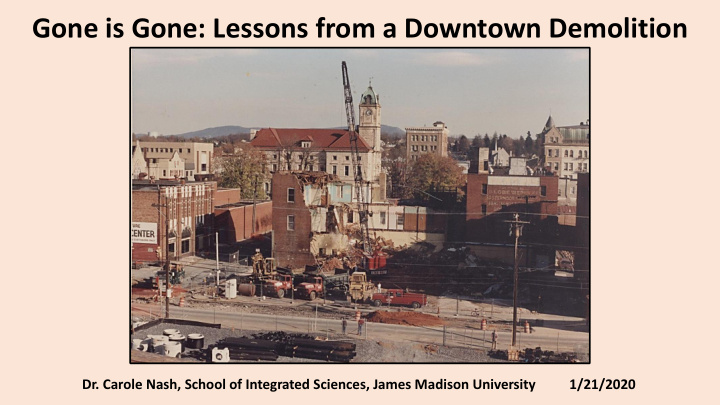



Gone is Gone: Lessons from a Downtown Demolition Dr. Carole Nash, School of Integrated Sciences, James Madison University 1/21/2020
The construction of the Rockingham- Harrisonburg Judicial Complex in the early 1990s was tied to the demolition of 17 structures in the Downtown core.
This occurred with limited community input and virtually no historic review .
Multi-Block Demolition and Community Impact: Northeast Harrisonburg
August 1989: public sees first plan for Judicial Complex (block between Market and Elizabeth Streets)
Harrisonburg-Rockingham Historical Society Library August 18, 1989
November 1990: plan for the current structures in place. Courts building on south side of West Market Street, between Liberty Street and Court Square; 5- story Jail building/Sheriff’s Office along Liberty Street between West Market and West Water Streets.
Harrisonburg Redevelopment and Housing Authority was authorized to negotiate the purchase of 17 properties. At the time of the announcement, City and County had already purchased the former JC Penney property (Vibes Nightclub), located on the southwest corner of Court Square, next to Denton’s.
Demolition permits were secured in August 1991. Work began on September 5 and concluded in December 1991.
Wayland (1949): There is less change on German Street than any other portion of town . Harrisonburg-Rockingham Historical Society Library D. J. Lake’s Atlas of Rockingham County Virginia, 1885 Drawing of T. Harrison’s 1780 Plat for Harrisonburg
Community organizations immediately voiced concerns: Citizens for Downtown Harrisonburg-Rockingham Historical Society Archeological Society of Virginia Assumption: Funding sources and required permits would initiate environmental and cultural review under Federal laws. Standing structures, historic infrastructure, and archaeological sites would be evaluated and considered for significance. Wrong: No Federal funding; Army Corps of Engineers invoked Nationwide Permit
August 1991: Rockingham County agreed to allow members of the Massanutten Chapter of the Archeological Society of Virginia two days to photograph the buildings. During the fall, chapter members took turns photographing the demolition from outside the construction fences .
Core area of historic settlement for Harrisonburg *Court Square *Market Street *German or Back Street “The working side of downtown along Blacks Run” Gray’s Map of Harrisonburg, 1887
1897: grocers, rooming house (Hotel Thurmond), milliner, carriage shop, cobbler shop, laundry, blacksmith, livery, dwellings
W.Market Street toward Courthouse, turn of 20 th Century (Suter and Lyon, 2003)
W.Market Street toward Courthouse, 1915 (Suter and Lyon, 2003)
By 1924, Denton’s had moved to Court Square and Market Street was one brick building after the other, filled with businesses and apartments.
Liberty Street was populated with small local businesses and dominated by the B and O Railroad.
What was lost?
West Market Street (South Side)
Blacks Run: stone arches and Native American sites
Wetsel Seed Company Parking Lot: B&O Depot (Union Station) E. Bumbaugh Collection
Zirkles Paint Store (site of Sullivan Cigar Factory) E. W. Sullivan Cigars (McAlister 2015)
Tan yard in back Jesse Bowlin House pre-1800 2-story log
Corner of Liberty and West Market: Ole Virginia Ham Café and Lindsay Eco Water (Fridles Bakery)
Jim Eaton’s Sinclair Station and Ole Virginia Ham Café, 1950s
Pro Pool Building (Paul Building) – grocery store and apartments
Back to Liberty Street: Rearview Bikes and F&J Sandwich Shop: early site of livery and carriage shop; tin shop from 1890s-1930s
Layman’s Restaurant and Salt’s Barbershop (Location of stables and dwellings)
Mystic Den (music venue) Location of earlier dwellings
Twin State Beauty Supply (19 th /early 20 th century dwellings)
Entrance off Water Street The Paper Box Factory (Campbell Shoe Co.; Tire Warehouse; Furniture Maker; Creamery). Portions rehabbed in 1980s to house arts-focused businesses.
Harrison Antiques (Myers House, 19 th Century; Pawn Shop)
Warehouse and Offices, B&O Railroad
The intrinsic value of older buildings: higher-quality materials, built by different standards. When the structure is removed, its possibility is lost.
Removed from Vicinity Since Jail Judicial Complex Completion Green Auto Parts Building Rhodes Candy Company Building
Don’t let this be next. Old buildings are reminders of a city’s culture and complexity; their owners and occupants contribute to the economic and social welfare of communities. Once they’re gone, they’re gone .
Gratitude Massanutten Chapter, Archeological Society of Virginia Eleanor F. Parslow Janice Biller Cindy Schroer John Eckman Citizens for Downtown Kathy Kraft Bob Bersson Harrisonburg Downtown Renaissance Andrea Dono Andy Perrine Virginia Department of Historic Resources Randy Jones Samantha Henderson
Recommend
More recommend